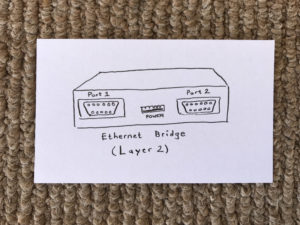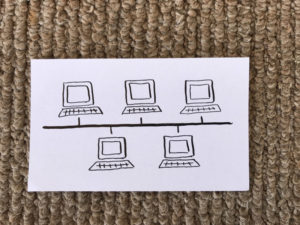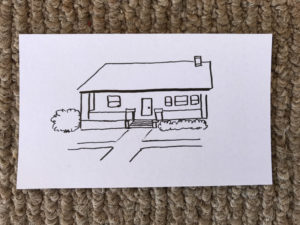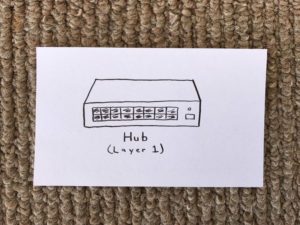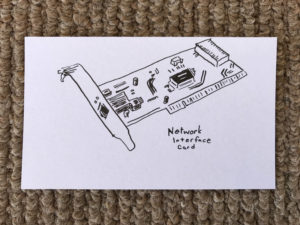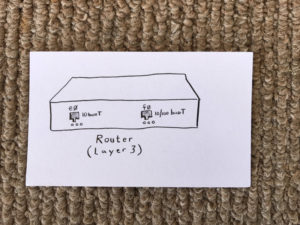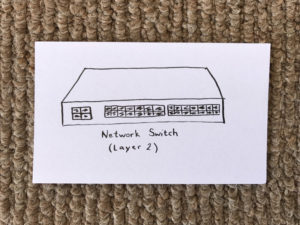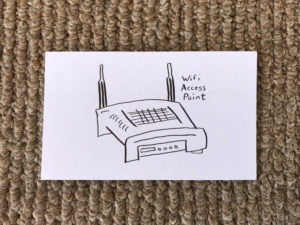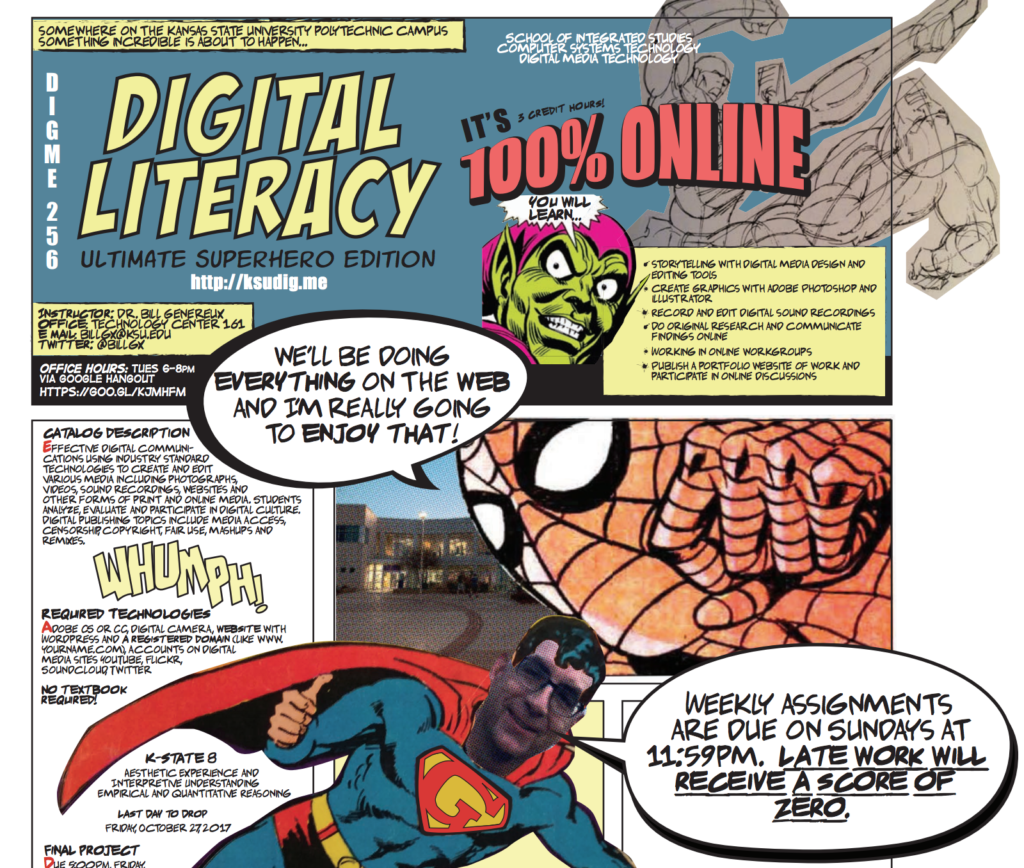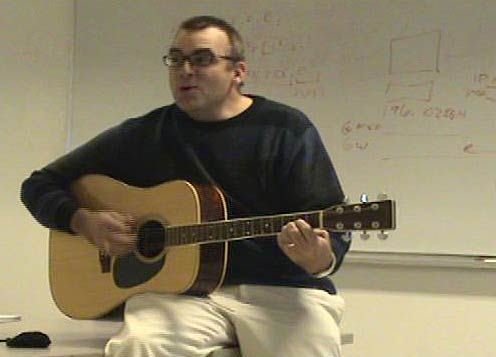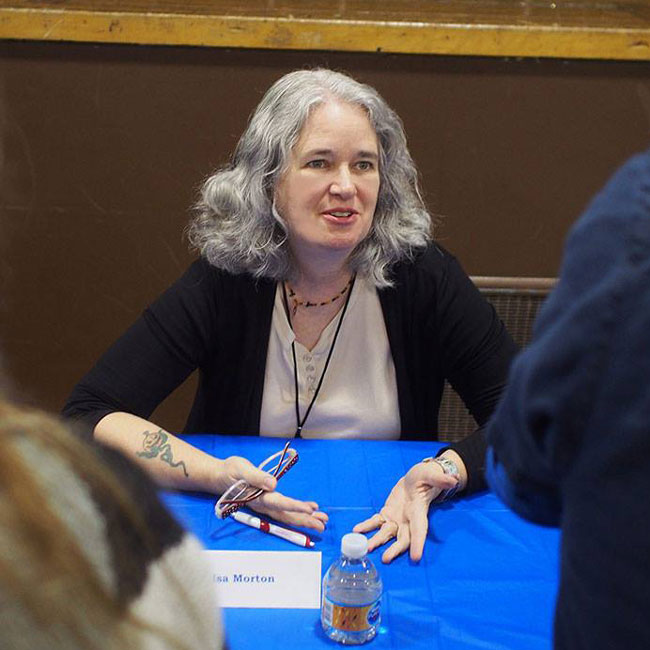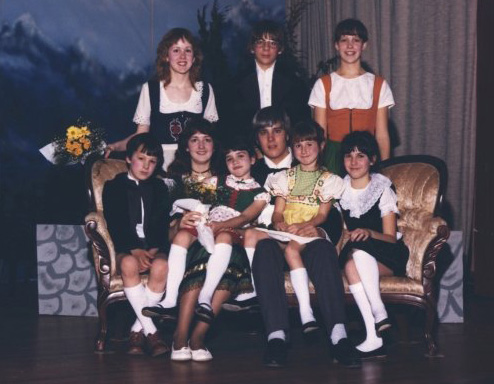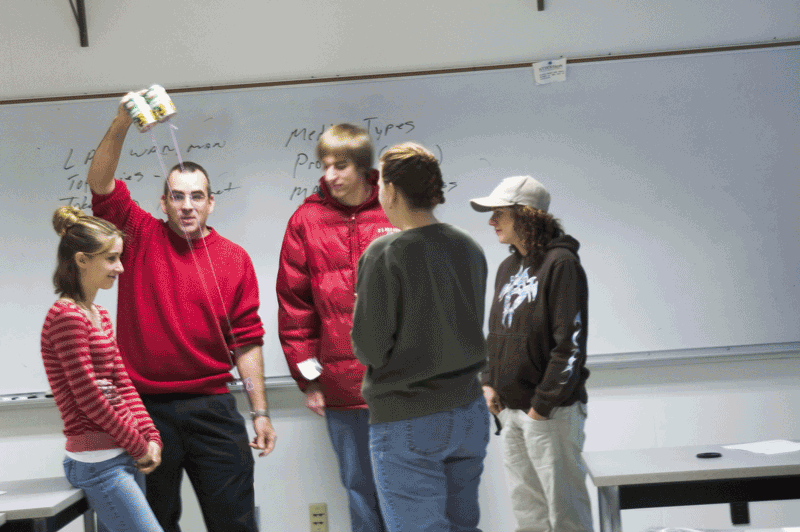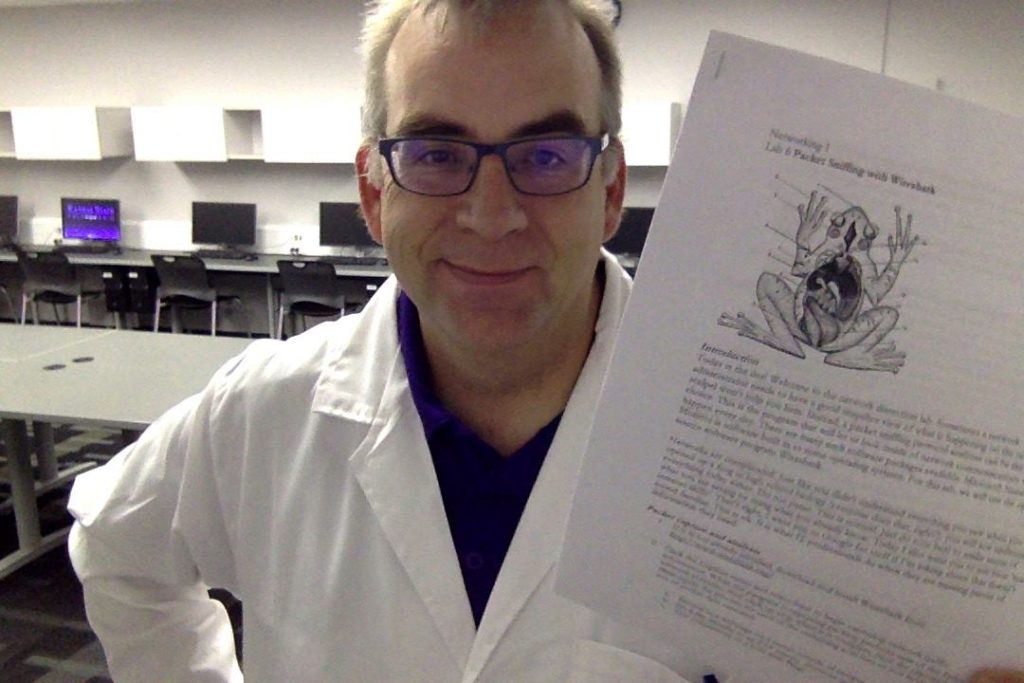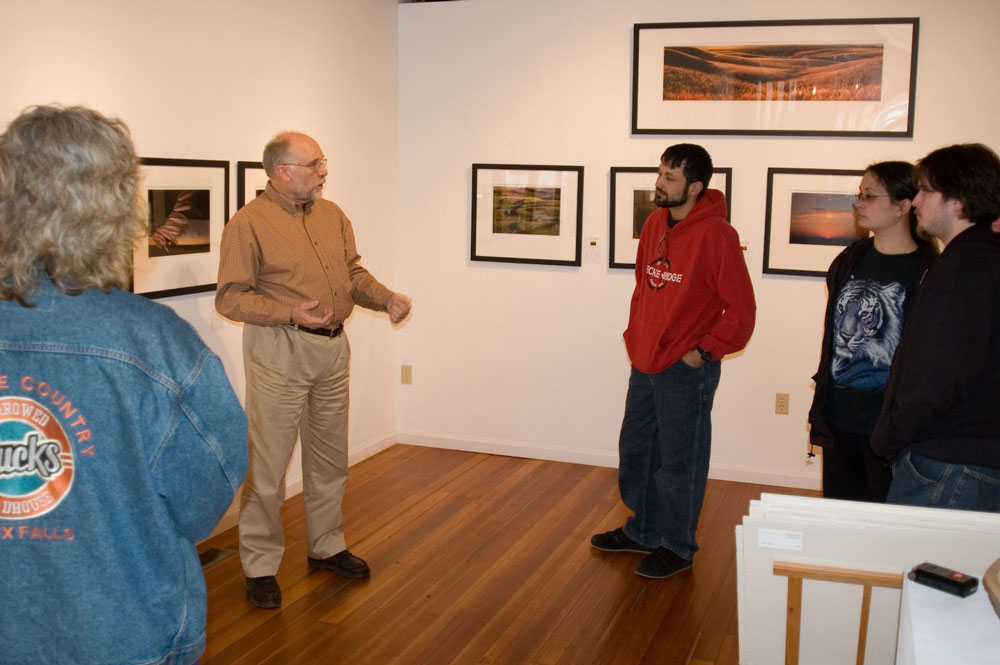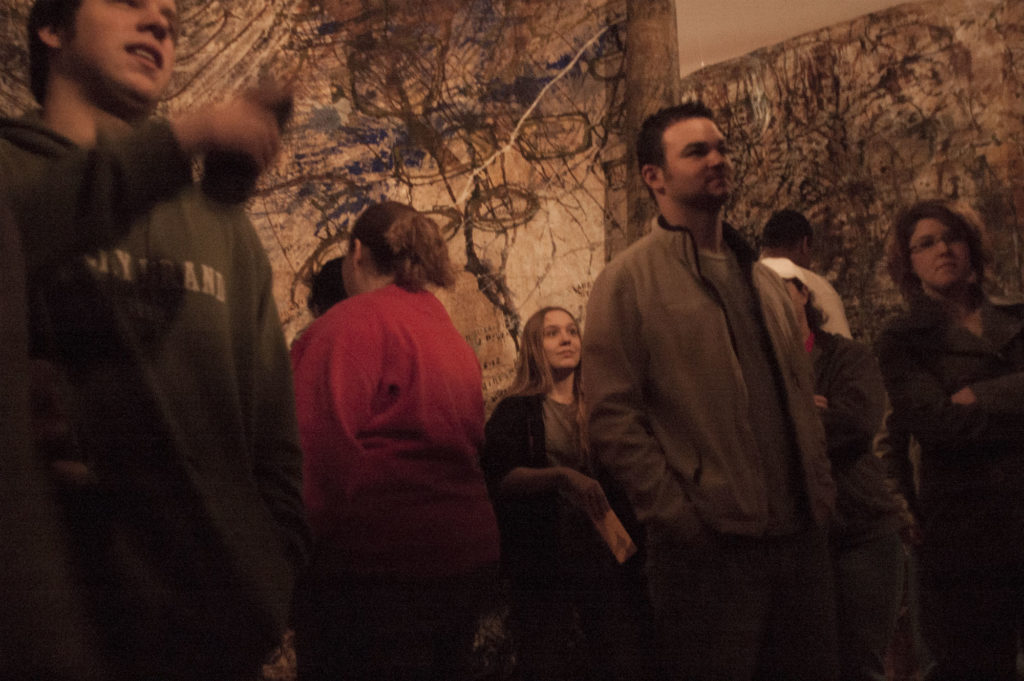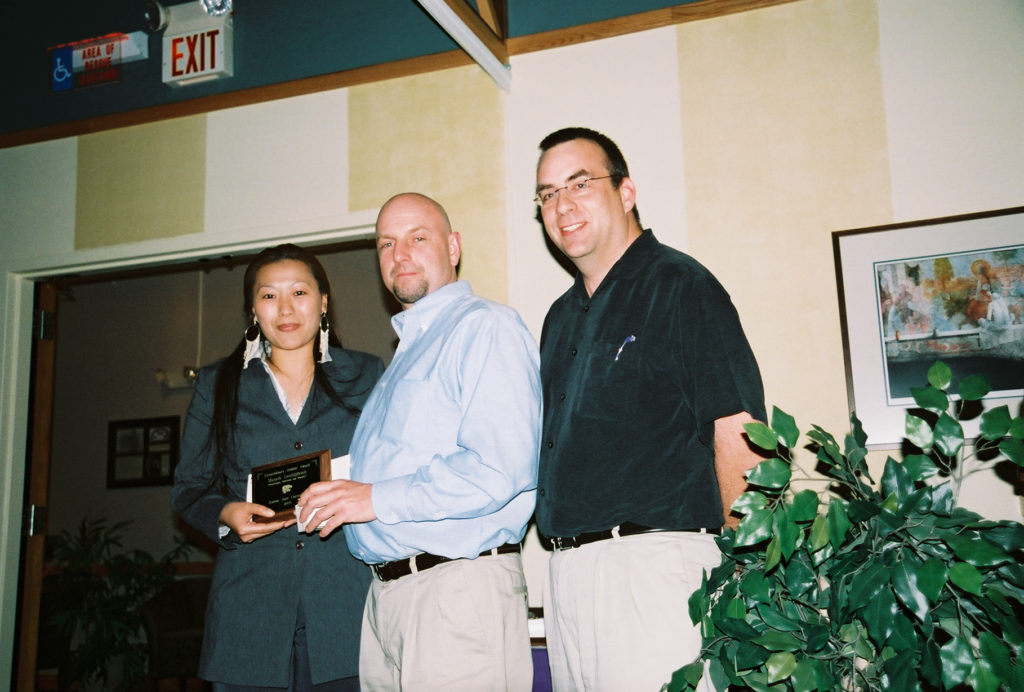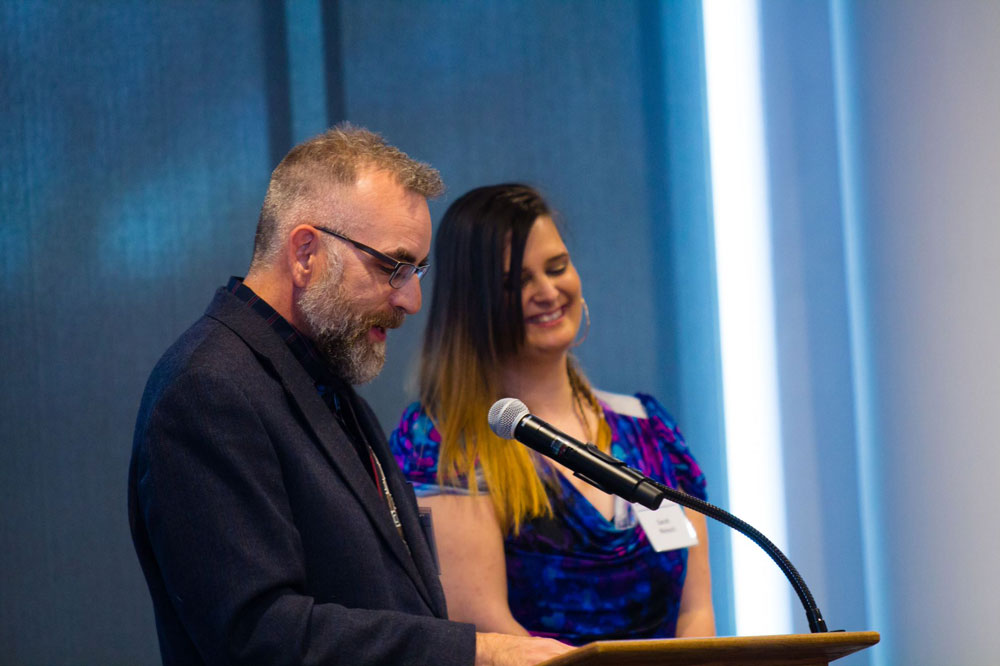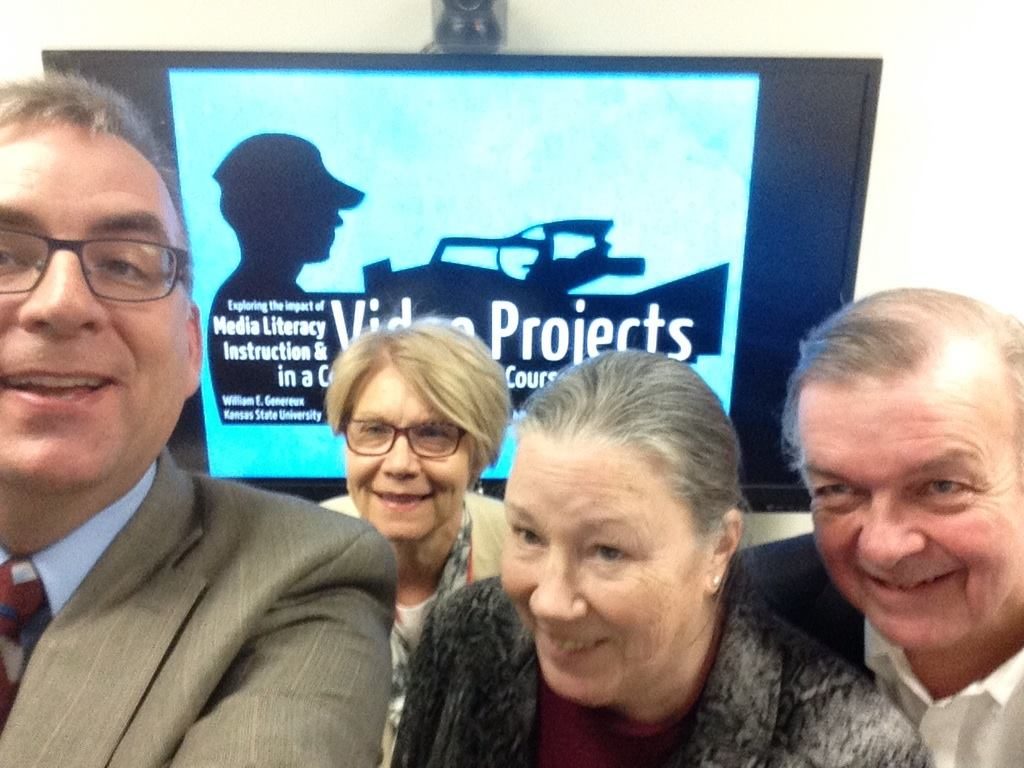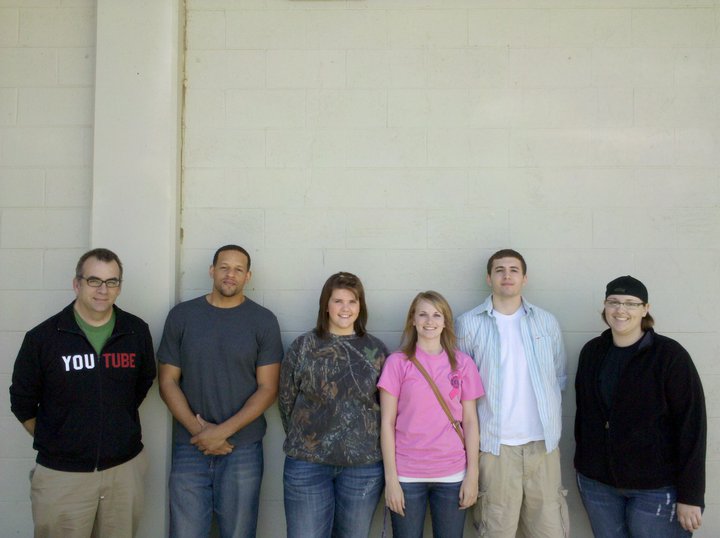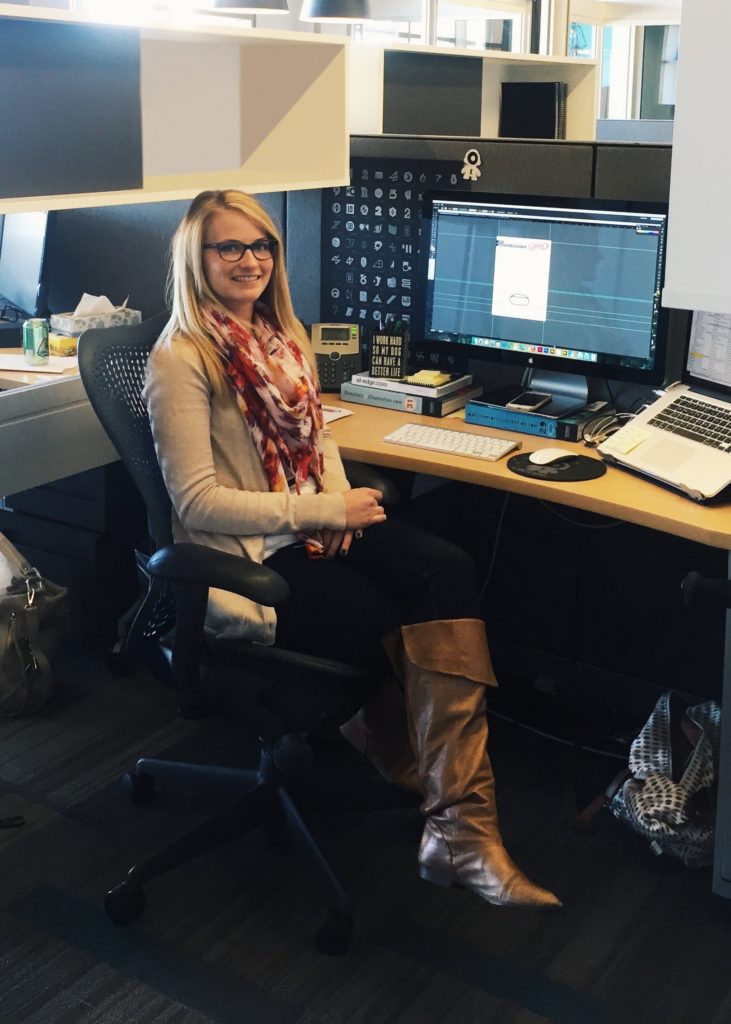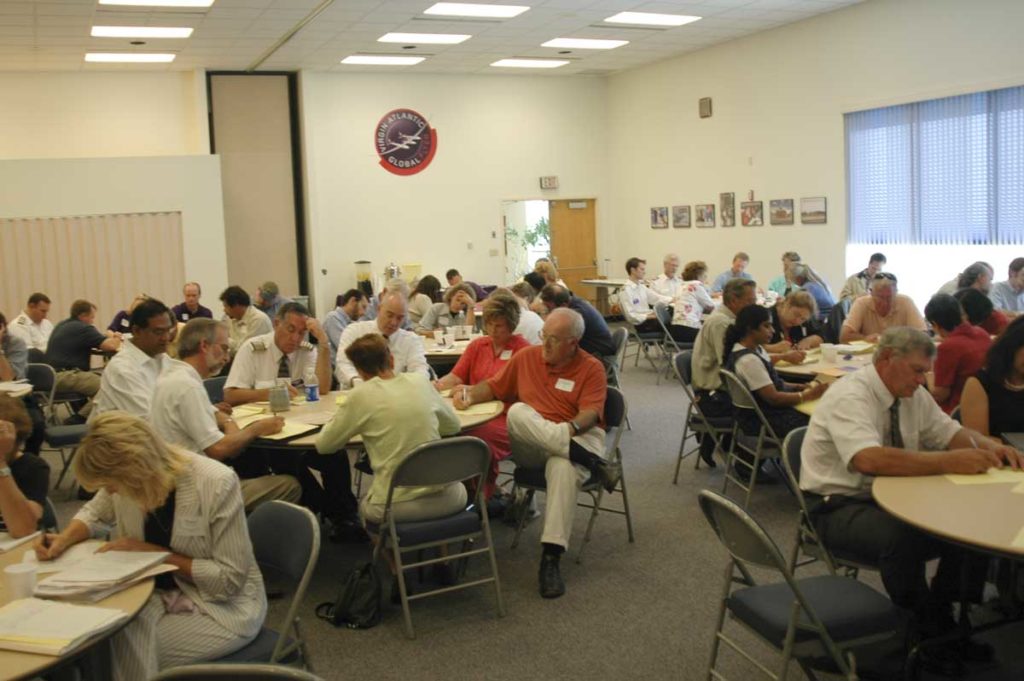An art history lecture I gave for our first year Mastering Academic Conversations course.
Category Archives: teaching
Adding Mediasite Content to Canvas
I added content hosted on Mediasite to my Canvas course once before, but promptly forgot how to do it and where to go to learn how again. A quick search online took me to the K-State Mediasite tutorial. Now, if I forget again, I can refer back to my own blog to find the link.
By the way, the main piece of information I was looking for was the fact that there is a special button on the Canvas interface for adding Mediasite content. That button looks like a blue “V” like this:![]()
That was all I needed to know to get myself back on track again!
Networking Hardware Slides
Wesch’s Tips for Teaching Online
Why Computers and Networking?
I’ve spent a fair amount of time revising this Powerpoint slide show that I like to show early in my CMST 250 Hardware and Networking course. Since I’ve redesigned it for a distance learning class and I’m putting lectures in video form, I thought I would update the random bits of art in the slides and hand-make new artwork for this presentation. This video shows the results of that effort. Most, but not all of the artwork in it was recently made by yours truly.
Merging Canvas Course Sections
Thanks to Lisa Shappee, our resident Canvas expert, I now know how to merge two course sections into one course. It is not an easily discoverable process, but the directions are recorded in this K-State how-to post.
Proudest Moments in Teaching
In no particular order, these are some of my proudest moments in teaching.
Graphic Syllabus
I have been intrigued by the notion of creating an infographic style of syllabus, so I have made a couple of them. It takes many hours to create something like this, but I think it is worth the effort to make something so unique for a college course.
Subnetting Song
Subnetting is probably the most challenging topic in my Hardware and Networking course. It isn’t overly complex, but it is unfamiliar to most students who take my class. To provide another way to think about the material, I wrote a silly song about it and do surprise performances of it in class. Sometimes students even sing along with me once they catch on. Having a sing-along in a computer class is completely unexpected, and that’s what makes it so wonderful.
Pumpkin Carving
In our Visual Literacy course, we study elements of design. Students conceive of a design to be carved on a Halloween jack-o-lantern, develop it using Adobe Illustrator graphics software, print it out, transfer it to the pumpkin and carve it out to create a complex image when lit. The assignment was so successful that I wrote a paper about it with colleague Katrina Lewis, and even went to Madrid, Spain to present it.
Guest Speakers by Skype
While doing the research for our pumpkin carving paper, I came across a history of Halloween book by Lisa Morton, an author who also happened to be the president of the Horror Writers Association. When we were exploring the horror genre in the digital literacy class I teach, I reached out to Lisa and invited her to visit with our students by Skype teleconference, and we had a really great visit with a well-known expert in her field.
Another great Skype my students and I did was when a national story came out about a teacher who reconciled with a student who had gotten him fired. Josh Kaplowitz was in his first year of teaching when a young boy, Raynard Ware, said that the new teacher had pushed him down. Kaplowitz was arrested, fired and humiliated. Years later, the older and different Ware reached out on Facebook, apologized for fabricating the story that cost his former teacher his teaching career and the two became friends.
I reached out to Mr. Kaplowitz and invited him to have a Skype with my students who were studying Social Media technology. He suggested that we include Raynard Ware and we ultimately wound up teleconferencing with both men.
/https://www.thestar.com/content/dam/thestar/news/insight/2015/01/31/teacher-who-lost-job-over-pushing-allegation-and-accuser-become-friends/raynard-ware-and-josh-kaplowitz.jpg)
Over the years, my students and I have had numerous Skypes and teleconference calls with designers, game programmers and even former students who graduated from the K-State digital media technology program. Each time we do, I am filled with awe at how simple it is to arrange such virtual meetings.
Theatrical Teaching
I got involved in theatre in high school. My very first musical production, shown above, was The Sound of Music in which I played the eldest Von Trapp boy. Most people I work with don’t realize how much I am still infected with this affinity for the dramatic. I love to do skits, simulations and role-playing in my classes.
In this skit, we are simulating a busy network using cans with strings “telephones” and how the CSMA/CD protocol acts as a referee that decides who may speak at a given time.
I created a “dissection lab” in the hardware and networking course in which we examine data packets sent by a device on a network. I dress up like a laboratory scientist with lab coat and safety goggles and a stuffed toy frog. Looking at these data packets is very similar to a high school biology lab in which you open up a frog and recognize a few things you have been learning about, but much of it is confusing and complex. We recognize a few protocols we have been discussing, but real networks, like real life organisms, are messy and complex.
In these parody videos of Spongebob and Shrek, I use my voice-acting skills to make the famous characters talk about technology topics we discuss in class.
Field Trips
A favorite stop for digital media students is the Small World Gallery in Lindsborg, KS, especially when we get to meet the owner, National Geographic photographer Jim Richardson. In the photo above, Jim is telling us about his latest work. Jim is such a treasure here in Kansas. He is always willing to talk with students and even shares technical details of his work with us.
Here are my students, fully immersed in an exhibit at the Salina Art Center. I am continually amazed that even lifetime residents of Salina have never set foot in the Art Center, so we often take field trips here to experience the artwork.
Extraordinary Student Awards
Probably the most rewarding part of my job is working with students who face extra challenges in their college studies because of their life situation. It might be that they are a single mother trying to support a family on their own while attending school. It might be that they have a condition that makes learning and/or social situations difficult. It might simply be that they come from a background filled with difficulty and turmoil. Whatever the situation, when I become aware of these students I do whatever I can to assist them on their journey.
Each year, Kansas State University recognizes about a dozen or so students who have overcome extraordinary circumstances to obtain their degree. There are many nominees and only these select few who are chosen to receive it. I have nominated two individuals who have won this award and it is my privilege to have known and worked with these students.
Manath Leuthiphonh receives the K-State extraordinary student award in 2007. She is doing well in her career and we keep in touch from time to time. Sadly, her classmate Scott Johnson (middle) was killed in a violent crime a few years ago. His was one of the two student funerals I have attended since becoming a college professor.
Sarah Welsch received her K-State Extraordinary Student Award in 2018. She has found meaningful work and is making a new life for herself thanks to her college degree.
Dissertation Defense
Words are inadequate to describe the feeling of this day; the day of my successful Ph.D dissertation defense. It is called Exploring the Impact of Media LIteracy Instruction and Video Projects in a Computer Technology Course. It details the research I did on using student-made video projects as an expanded form of literacy.
If you would like to see my students’ video projects, you can see some here.
Digital Media Degree Program
Last, but certainly not least, I am extremely proud of the K-State Polytechnic degree in Digital Media technology that I conceived of and helped to implement. The degree combines computer technology with the creative arts resulting in graduates with an extremely unique and marketable set of skills.
In the photo above are some of the very first students in the Digital Media degree, taken in 2010. From left to right are myself, Will Jones, Trista Bieberle, Sarah Woodruff, Brandon Moberly, and Kristin Scheele. Except for Brandon (anyone know where he is nowadays?) I am in touch with them all and they seem to be doing very well for themselves.
For example, Sarah Woodruff is now employed at Fervor in Kansas City as a senior graphic designer and user experience (UX) expert.
I am so proud of all of my students.
So there you have it; the list of my proudest moments in teaching. Anytime you try to create something like this, you will undoubtedly forget something important. But this gives a good overview of what I’ve been able to accomplish as a college educator.
Practice What You Preach
Oops!
I justify using external services instead of courseware discussion boards so students can always refer back to previous discussions if they choose. However, I just deleted all of last year’s students from our private DigMe406 LinkedIn group. Doh! I shouldn’t have done that!
Thankfully, not much happened for that group on LinkedIn, more happened on Twitter, which can’t be deleted. I’m hopeful that this year more private discussion will happen on LinkedIn because we are starting our discussion there. Last year we started on Canvas discussions then I tried to get them to move to LinkedIn and it didn’t work well. People want to stick with what they started with.
Reflections on Teaching Online Classes in 2018
I taught several online classes during 2018. In the spring and summer terms, I taught a course on Social Media. In the fall, I taught an online course on Digital Literacy. In all of these courses, I emphasized the use of social media and digital tools. For each class, I required a video teleconference at the beginning of the semester with each individual student. That took many hours to visit with each student for 20-30 minutes, but I think it was a good investment to make that initial connection.
In the spring Social Media class, I initially requested that each student use our Beam+ telepresence robot to video conference with me, but that was not a popular option so I relented and let students use a video chat tool like Skype or Zoom. In one case, the student’s bandwidth was so poor, we just switched to a regular telephone conversation. In that case, the student was interested in using the robot, but simply couldn’t make it work.
Some students downright refused to use the robot, which I guess is somewhat understandable since it was uncharted territory and required installing special software to make it work. However, for those students who did try the robot in several cases, they told me that they appreciated how “real” the experience felt. They visited me during office hours and I was able to give them a brief tour around our building, even introducing them to some other students on campus.
Even though it was a big assignment, points-wise, a few students opted to not do the teleconference at all. Those are the students who consistently did the most poorly of all. I need to think about how to ensure that all students utilize the video conference and build connections with them. Being an online student is a lonely business! It is important to know that real people are out there and that they care.
For both spring and summer editions of the Social Media class, I followed a strategy that I frequently use. I shared my syllabus with the students and asked that they provide feedback and suggestions on some key points on how the course would operate related to grading and participation. I believe that sharing some of the decision making and control with students can assist with helping them to take some ownership of their learning and the class.
With online classes, it is difficult for me to know with any precision the needs of my students and what challenges they might be facing. So in asking them about things like what reasonable participation frequency throughout the week looks like, I’m getting some vital information about what they think is reasonable and we can have a discussion about it.
However, one of my students commented in his feedback on the course that it was inappropriate for the instructor to ask for student opinions about how the class and syllabus requirements should be structured. I think this says a great deal about what that student thinks education should be, what a class should look like and what the role of teacher and pupil should be. Over the years, I have learned that students naturally gravitate towards passivity and when the teacher asks them to think about such things it falls far outside of their comfort zone. They would rather have the teacher do all of the heavy lifting on such things whenever possible. But my belief is that when I share control over some aspects of a course, it is no longer a dictatorship but becomes a form of shared governance. It gives students some agency and responsibility for how the course turns out. That can be a little daunting for some students, I think. But in the end, I think it is a good thing.
The fall 2018 Digital Literacy class was overall a good one. We experimented with using several forms of online media for communication. However, at one point, there was a student who had some major concerns about one particular topic and its content; that of objectification and body image. My response to that situation took a great deal of energy and reflection. I consulted with several colleagues and my supervisor about possible approaches.
Ultimately, I followed the advice of Dale Carnegie and took the blame myself and apologized just to keep the peace, but to no avail. I requested on several occasions to have a real-time visit about the situation because I know through experience that text-based communications can make a sensitive situation even worse, but my student decided that I was in the wrong and that a cold shoulder was the best response for me.
The sad part of that whole business was that I essentially shared the same point of view as my student. I don’t think that people should be viewed or treated as objects. I introduced this topic for discussion because it is an important conversation to have with college students. I don’t think it is considered often enough.
However, it was my first attempt at dealing with the topic and it was admittedly not handled with as much finesse as it could have been. I apologized and tried to explain my thinking, but it ultimately was a missed learning opportunity for that student. However it did open up a good discussion in the class though, and I believe that most of the students ultimately understood the purpose of the assignment, even if they too were surprised by what they saw (some others said they were).
In these classes, I work hard to keep things interesting and relevant. I challenge them with new ideas they might not have considered before. I emphasize critical thinking about the various forms of media they are using on a daily basis. We are using tools and technology in ways that they have never tried before. Learning is hard and it is uncomfortable to be challenged. But I think we are doing some good work in these online classes even though we will never meet face to face.
Teach On Conference – 2006
In August of 2006, K-State Polytechnic (then called K-State Salina) hosted an inter-institutional day of professional development for faculty from multiple institutions of higher learning in the region. The two main collaborating partners were Cloud County CC and K-State Salina.
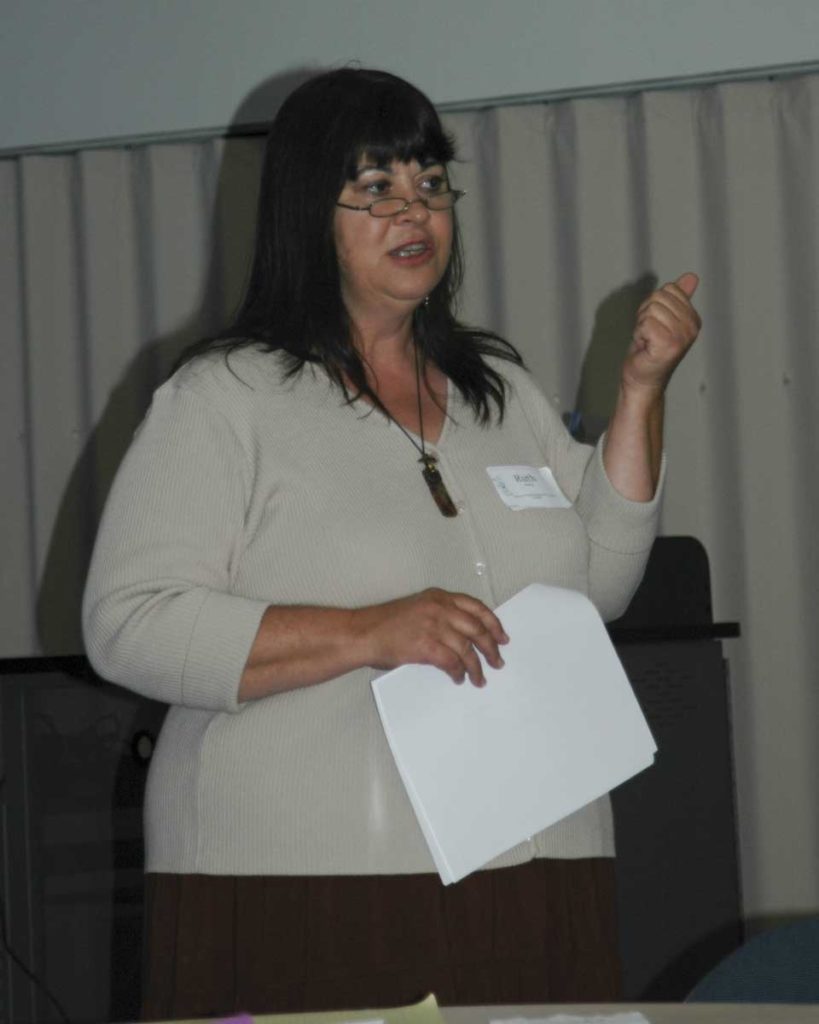 It was at this conference that I first met Ruth Moritz who was then working at Barton County. Ruth eventually found her way to teach on the K-State campus in Salina. We became good friends and I was deeply saddened when she left to teach for Kansas Wesleyan.
It was at this conference that I first met Ruth Moritz who was then working at Barton County. Ruth eventually found her way to teach on the K-State campus in Salina. We became good friends and I was deeply saddened when she left to teach for Kansas Wesleyan.

